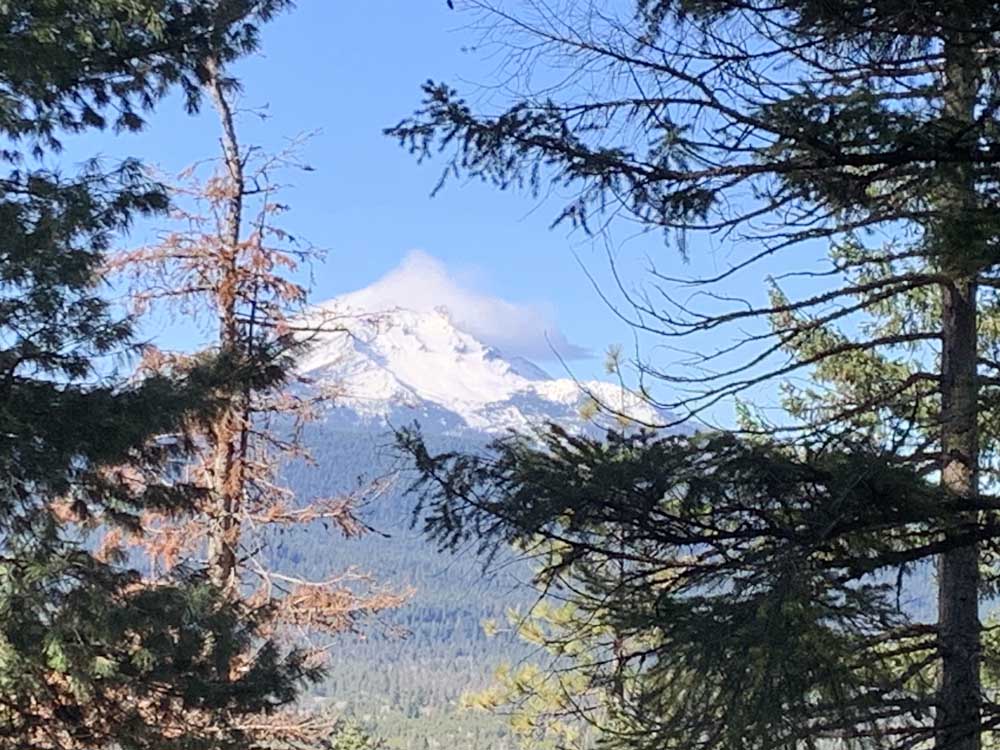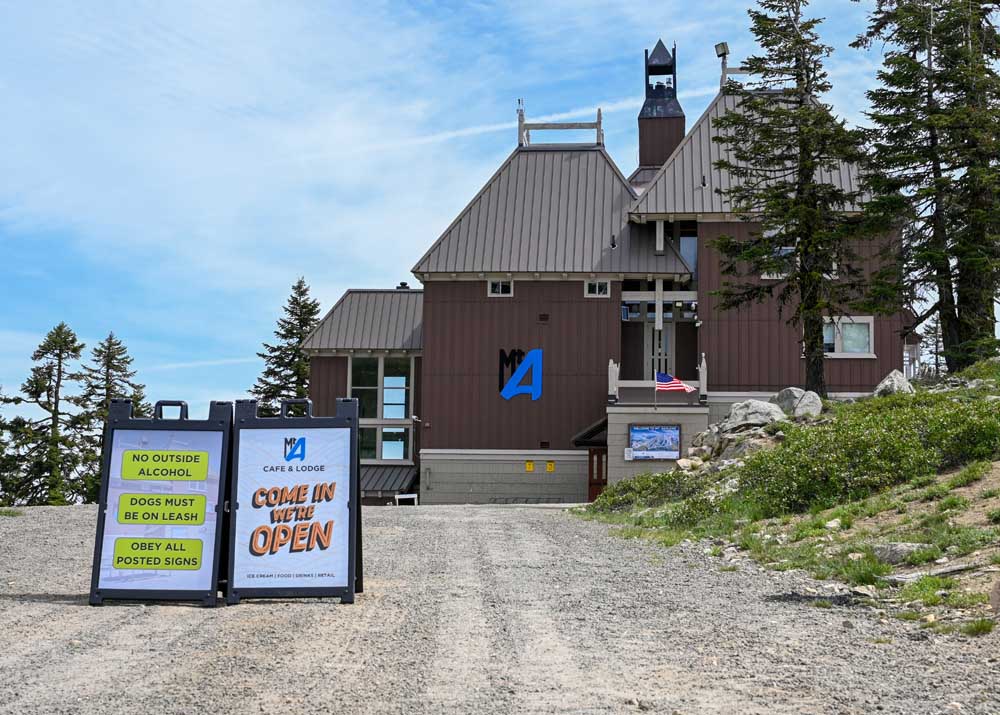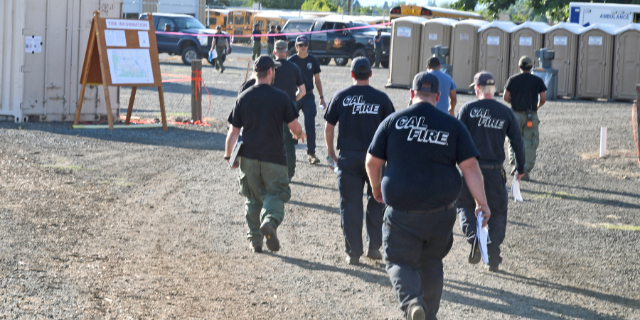Take in the views, relive memories while hiking the Tomahawk Trail
Published 8:30 am Saturday, November 18, 2023

- Views of snow-capped Mount McLoughlin are frequent along the Tomahawk Trail.
It’s a little-used trail, but not because there’s little to see.
Trending
Actually, the Tomahawk Trail offers a variety of views, from lush forests to openings that expose Pelican Butte, peaks in the nearby Mountain Lakes Wilderness, Upper Klamath and Agency lakes and, most of all, snow-capped Mount McLoughlin.
The one-way distance between the trailhead parking areas near the Crater Lake Zipline and Varney Creek Road 3610, near the Mountain Lakes Bible Camp, is about 2½ miles. Our out-and back trek led by Heather Berg, who knows the area because she’s a former Klamath Ranger District ranger, began and ended on Varney Creek Road. And, instead of going to the trailhead near the zip line, she led us cross-country to the top of Tomahawk Ridge, near but deliberately away from where the zip line rides begin.
It was a scenic, enjoyable hike. But for some, it was also a time to remember an earlier era.
Trending
For many years, the area was known as School House Hill and was near a Pelican Bay logging camp. The name changed to Tomahawk Ridge in the early 1950s when plans were announced to develop a ski area, the Tomahawk Ski Bowl.
From its opening in 1956 until it closed in 1984, the area was a “backyard” ski area, one primarily used by downhill skiers from nearby Klamath Falls. When it opened, a single rope tow provided uphill access. A ski lodge opened in January 1957, which included a café, bathroom, first aid station and dining area. Don and Marie Divens, who owned a Klamath Falls sporting goods store, and Howard Pernell and Troy Cook were the ski area’s developers.
A Poma lift was also added. A 1961 newspaper story described the Poma lift as “a chattering, cheerful complex of cables, wheels and dangling bars designed by the French to hoist a great number of skiers ‘quickly and comfortably.'”
Poma lifts were also sometimes called the “Pogo Sticks of the Ski Hills.” The lifts, which are still used in some ski areas and amusement parks, require riders to ski-step to a designated place, grab a disk-sized handle as it comes around, place it between their legs and get ready to ride. Poma discs are designed for straddling, not sitting, so it wasn’t unusual for people get tossed off, sometimes while attempting to board, and, more embarrassingly, in full view up the hill.
Unplanned dismounts looked and felt like being thrown off a buckin’ bull. At Tomahawk Ski Bowl, a tumbling dismount typically set off a cacophony of yips, howls and laughs from the line of skiers waiting their turn. Worse was catching a ski in a rut and falling off while high up the mountain. Because the lift went up the steepest part of the hill, the challenge, especially for beginners, was trying to collect often scattered poles and skis, then standing and negotiating a safe way down, all while trying to dodge others riding the lift up the hill.
As an alternative, beginning skiers and people who rode on sleds and snow shovels used one of the rope tows that went partway up the hill in less-steep sections.
In the 2018 Shaw Historical Journal, “Sports and Athletes in the Land of the Lakes,” Patricia Card remembers, “The funniest thing I ever saw was a mom and her daughter coming down on a sled, and they missed stopping at the bottom and went right out into the parking lot and under their own van. Thank heavens the opening under the van was up high. It would not have been so hilarious. Loved that ski park!”
In the same issue, Karon Sloan Bowker, tells, “It was a nice community place for people to go to … It was so easy to get to and it was nice to know the other skiers. I’d go with my parents, Robert Sloan and Peggy Johnson Sloan. Dad would complain about the price, $3 each or $12 for our family. I went in the 1950s until leaving for college in 1962. You had to learn how to handle the Poma lift, otherwise you’d be flying through the air.”
Since 2015, flying through the air has been offered another way — on the Crater Lake Zipline. The main canopy tour features nine ziplines, while a newer zipline is designed for youth age 5 to 12. For information about the zipline, go to craterlakezipline.com or call 541-892-9477.
After resting and snacking, our group of hikers doubled-back, zipping down our impromptu route to the trail and, a short time later, the Varney Creek Road parking area. Along the way, we passed clusters of mushrooms and paused to again appreciate Mount McLoughlin and the other sights.
There is a lot to see along the Tomahawk Ridge Trail. And, especially for longtime Southern Oregon skiers, a lot to remember.
Author’s memories
My memories of the Tomahawk Ski Bowl are among those included in the Shaw Journal.
On my first visit to Tomahawk, an expert skier friend followed me down an easy run from a rope tow then headed off to do some serious skiing. My skills progressed over the following weeks in what turned out to be Tomahawk’s final year.
As I recalled in the Journal, “I was a cross-country skier learning to downhill ski. It was challenging but the biggest obstacle was trying to ride Tomahawk’s Poma lift. I fell off every day, often several times, until finally, on my last ski day of the season, I rode to the top without a tumble. I took more pride in that than I did on not falling while skiing.”
Copies of the 2018 Shaw Journal, “Sports and Athletes in the Land of the Lakes,” are available at oit.edu/shaw, by emailing shaw.ib@oit.edu or by calling 541-886-1686.
The issue includes stories by and about Southern Oregon Olympians such as Dan O’Brien, Ralph Hill, Janice Romary, Rick Sanders, Jean Saubert, Glenn Jobe, Luke Klaja, Ian Dobson, Laurenne Ross, Chester Newton and Ashton Easton, plus tales about Liz Parrish (Iditarod’s Littlest Musher), baseball at the World War II Tule Lake Segregation Center, legendary basketball coach Danny Miles, author/boxer Louis L’Amour, ice skating on Lake Ewauna and the historic Crater Lake Wilderness Cross Country Ski Races.









